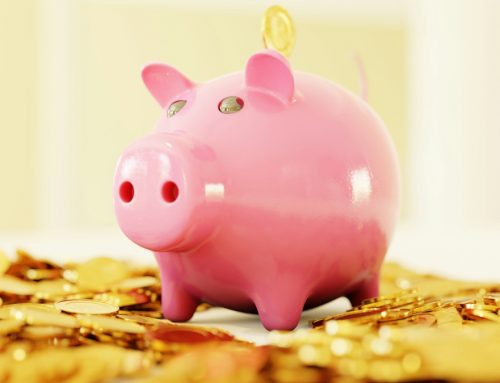Want to learn how to live off dividends? You’ve come to the right place. In this detailed guide to living off dividends in retirement, we’ll cover everything you need to know.
Retirement is supposed to be a time of relaxation and crossing things off your bucket list. It’s hard to enjoy what you’ve worked so hard your whole life for if you’re stressed over finances. But with the right stock portfolio, you can enjoy peace of mind as you live entirely off the dividend payments you earn.
It sounds too good to be true – can you live off dividends in retirement? It’s entirely possible, and people around the world are doing it right now. You can too – it just takes a bit of education and the right tools. With that said, you’re going to learn all about retiring on dividends down below. After reading this discussion, you’ll be ready to take action and start building your portfolio.
But to learn how to retire on dividends, you have to first understand – what are dividend stocks?
Benefits of a Dividend Portfolio in Retirement
Dividend stocks pay out a portion of their earnings to shareholders – these disbursements are known as dividends. They’re usually made quarterly, and they’re a great way to earn income from stocks without having to sell any shares.
Not all stocks pay dividends – so you’ll want to research those that do when building your portfolio according to this strategy.
Dividends are particularly valuable in retirement because they provide a consistent stream of income that can help cover living expenses. And, unlike bonds, dividend stocks offer the potential for capital gains as well as income. That means your portfolio can continue to grow even as you withdraw money from it.
So, are dividend stocks worth it? Of course, but not all dividend stocks are created equal. Some have higher yields than others, and some have greater potential for price appreciation.
With that said, these highest dividend paying stock come with an elevated sense of risk. Striking the right balance is especially important for retirees. You want safe high dividend stocks. Choosing the right dividend stocks is something we’ll cover in-depth later on.
First, can you live off dividends in retirement?
Can You Live Off Dividends?
The short answer is yes – it’s entirely possible to live off dividends in retirement. In fact, more and more people are doing it every day. The key is to start early, invest wisely, and reinvest your dividends so your portfolio can continue to grow.
Of course, there’s no guarantee that you’ll be able to retire on dividends alone. But since you’re here reading our detailed guide on how to retire on dividends, you’re already on the right track to success.
How Much Do You Need to Live Off Dividends?
Before we get into how to live off dividends in retirement let’s help you set your expectations. Retiring on dividends is going to take quite the nest egg. But the actual amount you need for living off dividends in retirement will be highly individualized.
There are two things to consider here: your annual expenses and the dividend yield of your portfolio. Start by estimating your yearly cost of living in retirement. Account for housing, utilities, groceries, healthcare, travel, and any discretionary spending. Be sure to subtract social security or any other income sources to get a more accurate number.
Say you need $50,000 annually, that becomes the income target for your dividend portfolio. From there you can consider the dividend yield, which is the annual dividend income as a percentage of a stock’s price.
Let’s assume a stock pays $5 in dividends annually, and currently trades at $100 per share. The yield is 5% – that simple. The typical dividend portfolio yields between 3-5%.
So if you need to make $50,000 from your dividends in retirement and your portfolio earns the middle of the range at 4%, you need $1.25 million invested in dividend stocks to generate enough income.
But, there’s only one problem: we haven’t accounted for taxes on dividend income yet. This is going to eat into your income every year and inflation is going to erode purchasing power as well.
All of this is to say that you’ll need to aim a bit above your initial target for living off dividends in retirement. You can run the numbers for historical inflation and your specific tax rate for a more accurate sense of how to retire on dividends.
You can also learn more about the pros and cons of dividend stocks in our blog. With that said, time is ticking – so let’s get into how to live off dividends in retirement.
How to Live Off Dividends: Step-by-Step Guide to Living Off Dividends in Retirement
The process of living off dividends in retirement is very simple – but that doesn’t mean it’s easy. It takes complete dedication from an early age to make this strategy work.
We’re going to lay out this information for someone who is just starting retirement planning and wants to enjoy the most comfortable, stress-free retirement possible. We’re assuming you have time on your side to still build up a nest egg in your career before retiring.
With that said, much of the advice is relevant to those who are approaching retirement and want to move their cash from a traditional cash savings account, 401K, or IRA directly into dividend-paying stocks.
So, without any further ado, let’s start with step one for how to live off dividends – getting your money to work as early as possible.
First Things First – Start Investing Today if You Haven’t Already!
Retiring on dividends doesn’t happen overnight. Even living off dividends at 40 can be tough. We have a complete guide detailing the advantage of investing early for retirement.
There, we discuss the compounding effects of time. Specifically, the manner in which they can affect your portfolio. By starting early, you can spend less to achieve your retirement goal compared to someone who starts after you.
To give you an idea of how much of an impact compounding can have, let’s say you start with $10,000 and earn 10% on your investments each year. If you reinvest your dividends and don’t make any additional contributions, in 30 years you’ll have almost $200,000.
Now, let’s say you wait 10 years to start investing. In that case, you’ll need to earn 12.7% annually to end up with the same $200,000 after 30 years. And if you wait 20 years? You’d need to earn a whopping 16.4% annually.
As you can see from this example, the power of compounding is very real. So, if you want to retire on dividends, the best thing you can do is start investing now – even if it’s just a little bit each month. There’s nothing wrong with small account trading – you need to start somewhere, after all!
With all this said, there’s nothing you can do about not starting early enough – you can’t go back in time and make different life choices. The best time to start investing was a few years ago. The next best time is today – so, take action when you’re done reading this guide on how to retire on dividends!
When Retirement Comes Around, Move Cash to Stocks and Bonds
Fast forward to retirement – you’ve done a great job saving up a sizable nest egg, and it’s time to kick your feet up and relax. But as you learned in our article on how to invest after retirement, the journey is far from over.
It’s very rare that you’ll have saved up enough in your retirement account to just live off cash alone. You do need to put a certain amount into cash or cash instruments – but only up to a year or two of living expenses.
The rest of your cash should be put into investments that don’t just preserve capital – they generate a return. This will help you outpace inflation and ensure your retirement goes as planned, accounting for unexpected expenses along the way.
There are two main assets that you’ll look to: stocks and bonds. Bonds are a safe, low-return option that will help you manage risk as you invest another chunk of your cash into stocks. More specifically, high-yielding dividend stocks.
The specific retirement portfolio allocation for which to invest in stocks and bonds will vary from person to person. It depends on how much you have saved up, how long your retirement is projected to be, annual expenses, and your risk tolerance.
The biggest determinable factor, though, is your annual expenses. Say your retirement is going to cost you $50,000 a year. But you get a few thousand a month for social security – bringing your total expenses down to $26,000 a month, perhaps.
That means if you’re hoping to live off dividends in retirement, you need your dividends to bring in this cash annually. Totally feasible with a large enough stock portfolio.
So, let’s move on to the next step – taking your cash from a 401K, savings account, or IRA and moving into individual stocks.
Build a Bulletproof Portfolio
First, we encourage you to purchase individual stocks rather than invest in funds. There’s a reason for this – control. Funds track broad performance – but they may not align with your unique standards for investing in a company.
Moreover, funds are notorious for paying variable dividends – you don’t know what you’re getting month after month. That type of uncertainty can add unnecessary stress at a time when you’re supposed to be living life on easy street.
That’s not to say you should simply go out and buy a handful of random dividend-paying stocks – even if they’re considered to be the best dividend stocks. You need to carefully consider diversification.
A solid strategy is to pick somewhere between 20-40 different dividend stocks to start your portfolio with. This will help you eliminate company-specific risks. Furthering your diversification efforts, make sure no more than 25% of your portfolio is invested in any single sector. You should also execute positions of equal size to keep all your investments uniform. This will make it easier to assess performance in the long run.
Now – how do you go out and actually find dividend stocks? At VectorVest, we make it easy. Our system can show you the top dividend stocks at any given time. We have an entire section of stock picks in our software dedicated to retirement. You can simply pick the ones that align with your strategy – whether that be the safest stocks, the highest-yielding stocks, or a combination of the two.
We’ll talk more about VectorVest – and how it can assist you with living off dividends in retirement – later on.
Reinvest Dividend Income Back Into Dividend-Paying Stocks
As we briefly touched on above, reinvesting dividends is essential to retiring on dividends. And it’s not just for the short-term gains, either – reinvesting dividends is how you make this a sustainable plan for the long haul.
Now, if you’re living off dividends in retirement, you obviously need to pull some of the cash out to sustain your lifestyle. This is part of the beauty of retiring on dividends – you don’t have to deplete the principal in your account. You can take what you need from dividends and reinvest the rest.
But where and how should you reinvest your dividend income? Ideally, into one of the very same stocks that paid it out to you! If you aren’t sure where to find your next dividend paying stock, here are some resources to point you in the right direction:
- Best blue chip dividend stocks
- Best stocks for Roth IRA
- Monthly dividend stocks to hold forever
- Cheap monthly dividend stocks
With that being said, you shouldn’t just reinvest all of your dividends into the same exact stocks. That’s how you become over-concentrated in certain companies and sectors. Instead, reinvest dividend income into a handful of other high-quality dividend stocks to help further diversify your portfolio. This is how you make the most out of compounding as well – which is critical when living off dividends in retirement.
Additional Tips for Living Off Dividends in Retirement
As you can see, learning how to live off dividends in retirement is quite simple. While executing this strategy to perfection is rarely easy, the steps to make it happen are not complicated.
Now that we’ve taught you how to retire on dividends, we want to leave you with a few additional tips for maximizing the success you see through this investment strategy for retirement.
Understand the Risk/Reward Ratio With High Dividend Yields
One of the most common mistakes investors make is chasing high dividend yields. It’s easy to get caught up in headlines like “This Stock Has a 15% Dividend Yield!” and go out and buy it without doing any further research.
While a high dividend yield can be enticing, you need to understand the risk/reward ratio before making any decisions. Just because a stock has a high yield doesn’t mean it’s worth the investment.
A quick Google search will show you horror stories of people who bought penny stocks with insanely high yields – only to see those companies go bankrupt shortly thereafter. Or worse – a friend told them about a high-yield dividend, so they closed out other positions to allocate cash to new opportunities. But then the next year, the company chops their dividend payouts altogether!
While the idea of earning a 15% or 20% return on your investment might sound great at first, it’s simply not worth the risk in most cases. If a company is paying out such a high yield, there’s usually something wrong. Do your due diligence before buying any stock – especially if it has an abnormally high dividend yield.
Consider Other Ways to Invest for Income in Retirement
If you’re looking for how to retire on dividends, know that you’re not limited to stocks that pay regular cash dividends. There are other ways to go about generating income from investments, too.
Bonds are one example. Although bond yields are at all-time lows right now, they’re still relatively safe investments. And when interest rates eventually do start rising again, bond prices will fall – providing investors with an opportunity to buy them at a discount. You can also learn about the best index funds for retirement in our blog – another great type of retirement investment.
Real estate is another solid investment for retirees looking for how to generate retirement income. While real estate can be a more hands-on investment, there are ways to invest in real estate passively as well. For example, through a Real Estate Investment Trust (REIT). When you invest in a REIT, you’re essentially investing in a portfolio of properties – without having to go out and buy them yourself. And the best part is, REITs must pay out at least 90% of their taxable profits each year in the form of dividends.
Follow the 4% Rule
Learning how to live off dividends in retirement is as simple as following the 4% rule. This will guide your withdrawal year in, year out without depleting your savings. It’s typically used for portfolios containing stocks and bonds, but can be adapted for dividend-portfolios as well.
The rule states you shouldn’t withdraw more than 4% of your total investment annually. For example, if your portfolio is worth $1 million, you need to live off $40,000 a year. Ideally, that $40,000 would come directly from dividends, leaving the principal untouched.
This conservative approach keeps your portfolio producing over time so your savings don’t run dry while you’ve still got life left to live. It also provides a buffer against market downturns.
Just remember that the 4% rule is a benchmark, and you can adjust it depending on your portfolio’s performance, lifestyle changes, or unexpected expenses.
Be Proactive in Readjusting Your Portfolio
Living off dividends in retirement isn’t just about buying the right stocks, you also need to know when to sell dividend stocks if they’re not performing well. Even reliable dividend-paying companies can face challenges, leading to cuts or eliminations.
Regularly reviewing your holdings helps you replace underperforming stocks with more stable or higher-yielding options. You should take this opportunity to evaluate sector performance as well. Sectors that once performed well may become overrepresented in your portfolio, increasing risk.
Selling your stocks at the right time is one of the hardest parts of learning how to live off dividends in retirement. Investors find themselves getting emotionally invested just as much as they are financially, and they stick with a losing position far longer than they should.
The best way to avoid this is having a trading plan and sticking to it. You cut losses no matter what at a certain point. Better yet, rely on a software that does it for you and prevents you from getting in your own way.
Invest in Software That Helps You Find the Top Dividend Paying Stocks
As we mentioned earlier, the best way to ensure a high rate of success with any investment strategy is to arm yourself with the right tools and resources.
Whether you want to learn how to live off dividends in retirement or how to sell covered calls, you need a repeatable approach for finding and executing on your opportunities.
Here at VectorVest, we have a blog full of resources that help you find stocks for trading. You’ll learn about analyzing stocks, trading indicators, and more.
But the best way to find the top dividend-paying stocks? Simply invest in a subscription to VectorVest’s stock forecasting tools and let us do all the hard work of finding them for you. You’ve worked hard enough to get to this point – why not go out and actually enjoy your retirement?
VectorVest helps you identify strong dividend stocks by evaluating both yield and financial health, ensuring you avoid unsustainable dividends.
Our system gives you a clear buy, sell or hold recommendation for any stock, at any time. You never have to let emotion or guesswork affect your decision-making again. Better yet, we have pre-curated stock picks that are updated daily. You can just pick the safest dividend stocks according to our recommendations and let your cash work best you. It’s that easy!
Final Thoughts on How to Retire on Dividends
Now that you know how to retire on dividends, it’s time to take action and start building your portfolio. Dividend stocks offer a great way to generate income in retirement, but it’s important to choose wisely and manage your portfolio carefully. With the steps laid out above, you’ll be well on your way to financial freedom.
Investing can be complex and confusing – but it doesn’t have to be. At VectorVest, we’ll simplify the stock market for you and help you achieve your retirement goals on autopilot.







Leave A Comment